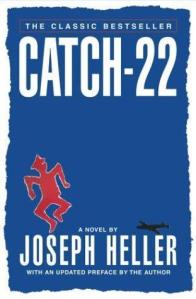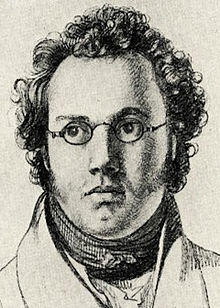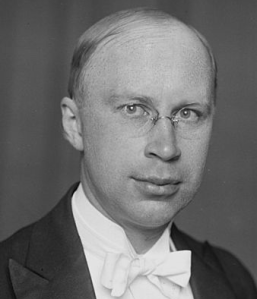Catch-22 by Joseph Heller;  Simon & Schuster Paperbacks, New York, 2004
Simon & Schuster Paperbacks, New York, 2004
Catch-22 was first published in hardback in October 1961; a paper-back edition followed a year later. It has now been translated into at least 21 languages and sold more than 10 million copies. I read it for the first time 50 years ago, and it has been one of my favorite books ever since. I must have read it a dozen times. It is one of the few books I know that can make me laugh out loud no matter how many times I read it, and that never fails to impress me with its wit and wisdom.
There is a great deal of critical analysis of Catch-22 available online, as well as a number of informative interviews with Joseph Heller. This review is not an attempt at further analysis; nor is it a rehash of the analysis of others. I simply want to give those who haven’t read Catch-22 an idea of what it’s about and to share a few of my favorite lines and passages. If even a few are thereby prompted to read it, I will be satisfied, and if one or two of those come to share my enthusiasm for it, I will be positively delighted.
Central to Catch-22 is the idea of contradiction, of paradox. Heller introduces this idea even before the story begins, in the novel’s epigraph: “There was only one catch… and that was Catch-22.” Such contradictions abound throughout the novel. Here are three more, all from just one page of Chapter 1, “The Texan”:
Across the aisle from Yossarian was Dunbar, and next to Dunbar was the artillery captain with whom Yossarian had stopped playing chess. The captain was a good chess player, and the games were always interesting. Yossarian had stopped playing chess with him because the games were so interesting they were foolish…
Dunbar was lying motionless on his back again with his eyes staring up at the ceiling like a doll’s. He was working hard at increasing his life span. He did it by cultivating boredom. Dunbar was working so hard at increasing his life span that Yossarian thought he was dead…
The Texan turned out to be good-natured, generous and likable. In three days no one could stand him…
And here is one more.
Major Major had been born too late and too mediocre. Some men are born mediocre, some men achieve mediocrity, and some men have mediocrity thrust upon them. With Major Major it had been all three. Even among men lacking all distinction he inevitably stood out as a man lacking more distinction than all the rest, and people who met him were always impressed by how unimpressive he was.
Heller first describes Catch-22 in the following passage from Chapter 5, “Chief White Halfoat”.
There was only one catch and that was Catch-22, which specified that a concern for one’s own safety in the face of dangers that were real and immediate was the process of a rational mind. Orr was crazy and could be grounded. All he had to do was ask; and as soon as he did, he would no longer be crazy and would have to fly more missions. Orr would be crazy to fly more missions and sane if he didn’t, but if he was sane he had to fly them. If he flew them he was crazy and didn’t have to; but if he didn’t want to he was sane and had to. Yossarian was moved very deeply by the absolute simplicity of this clause of Catch-22 and let out a respectful whistle.
“That’s some catch, that Catch-22,” he observed.
“It’s the best there is,” Doc Daneeka agreed.
Catch-22 is a veritable gold mine of quotable lines. Here are two of my favorites:
“Actually, there were many officers’ clubs that Yossarian had not helped build, but he was proudest of the one on Pianosa.”
“And if that wasn’t funny, there were lots of things that weren’t even funnier.”
And this is perhaps one of the most important lines in the book, an unambiguous expression of one of the novel’s central ideas, and a wonderful example of Heller’s wit.
“Clevinger was dead. That was the basic flaw in his philosophy.”
Along with its many memorable lines, there are innumerable noteworthy passages in Catch-22. I’ve chosen several to share here; the first is from Chapter 8, “Lieutenant Scheisskopf”.
Not even Clevinger understood how Milo could do that, and Clevinger knew everything. Clevinger knew everything about the war except why Yossarian had to die while Corporal Snark was allowed to live, or why Corporal Snark had to die while Yossarian was allowed to live. It was a vile and muddy war, and Yossarian could have lived without it – lived forever, perhaps. Only a fraction of his countrymen would give up their lives to win it, and it was not his ambition to be among them. To die or not to die, that was the question, and Clevinger grew limp trying to answer it. History did not demand Yossarian’s premature demise, justice could be satisfied without it, progress did not hinge upon it, victory did not depend upon it. That men would die was a matter of necessity; which men would die, though, was a matter of circumstance, and Yossarian was willing to be the victim of anything but circumstance. But that was war. Just about all he could find in its favor was that it paid well and liberated children from the pernicious influence of their parents.
In various places throughout the novel, Heller abandons his ironic tone, and the result is chilling. Take this passage, for example, also from Chapter 8.
Clevinger recoiled from their hatred as though from a blinding light. These three men who hated him spoke his language and wore his uniform, but he saw their loveless faces set immutably into cramped, mean lines of hostility and understood instantly that nowhere in the world, not in all the fascist tanks or planes or submarines, not in the bunkers behind the machine guns or mortars or behind the blowing flame throwers, not even among all the expert gunners of the crack Hermann Goering Antiaircraft Division or among the grisly connivers in all the beer halls in Munich and everywhere else, were there men who hated him more.
Here is an idea that recurs several times in the novel, from Chapter 9, “Major Major Major Major”.
“Would you like to see our country lose?” Major Major asked.
“We won’t lose. We’ve got more men, more money and more material. There are ten million men in uniform who could replace me. Some people are getting killed and a lot more are making money and having fun. Let somebody else get killed.
“But suppose everybody on our side felt that way.”
“Then I’d certainly be a damned fool to feel any other way. Wouldn’t I?”
In Chapter 12, “Bologna”, we have a heated debate between Clevinger and Yossarian about an issue that lies at the very heart of Catch-22.
Clevinger agreed with ex-PFC Wintergreen that it was Yossarian’s job to get killed over Bologna and was livid with condemnation when Yossarian confessed that it was he who had moved the bomb line and caused the mission to be cancelled.
“Why the hell not?” Yossarian snarled, arguing all the more vehemently because he suspected he was wrong. “Am I supposed to get my ass shot off just because the colonel wants to be a general?”
“What about the men on the mainland?” Clevinger demanded with just as much emotion. “Are they supposed to get their asses shot off just because you don’t want to go? Those men are entitled to air support!”
“But not necessarily by me. Look, they don’t care who knocks out those ammunition dumps. The only reason we’re going is because that bastard Cathcart volunteered us.”
“Oh, I know that,” Clevinger assured him, his gaunt face pale and his agitated brown eyes swimming in sincerity. “But the fact remains that those ammunition dumps are still standing. You know very well that I don’t approve of Colonel Cathcart any more than you do.” Clevinger paused for emphasis, his mouth quivering, and then beat his fist down softly against his sleeping bag. “But it’s not for us to determine what targets must be destroyed or who’s going to destroy them or – ”
“Or who gets killed doing it? And why?”
“Yes, even that. We have no right to question – ”
“You’re insane!”
“ – no right to question – ”
“Do you really mean that it’s not my business how or why I get killed and that it is Colonel Cathcart’s? Do you really mean that?”
“Yes, I do,” Clevinger insisted, seeming unsure. “There are men entrusted with winning the war who are in a much better position than we are to decide what targets have to be bombed.”
“We are talking about two different things,” Yossarian answered with exaggerated weariness. “You are talking about the relationship of the Air Corps to the infantry, and I am talking about the relationship of me to Colonel Cathcart. You are talking about winning the war, and I am talking about winning the war and keeping alive.”
“Exactly,” Clevinger snapped smugly. “And which do you think is more important?”
“To whom?” Yossarian shot back. “Open your eyes, Clevinger. It doesn’t make a damned bit of difference who wins the war to someone who’s dead.”
Clevinger sat for a moment as though he’d been slapped. “Congratulations!” he exclaimed bitterly, the thinnest milk-white line enclosing his lips tightly in a bloodless, squeezing ring. “I can’t think of another attitude that could be depended upon to give greater comfort to the enemy.”
“The enemy,” retorted Yossarian with weighted precision, “is anybody who’s going to get you killed, no matter which side he’s on, and that includes Colonel Cathcart. And don’t you forget that, because the longer you remember it, the longer you might live.”
But Clevinger did forget it, and now he was dead…
It occurs to me that Clevinger would have felt right at home in the German Army.
In Chapter 18, “The Soldier Who Saw Everything Twice”, we have the following exchange, one which epitomizes Heller’s brilliant wit.
Thanksgiving Day came and went without any fuss while Yossarian was still in the hospital. The only bad thing about it was the turkey for dinner, and even that was pretty good. It was the most rational Thanksgiving he had ever spent, and he took a sacred oath to spend every future Thanksgiving Day in the cloistered shelter of a hospital. He broke his sacred oath the very next year, when he spent the holiday in a hotel room instead in intellectual conversation with Lieutenant Scheisskopf’s wife, who had Dori Duz’s dog tags on for the occasion and who henpecked Yossarian sententiously for being cynical and callous about Thanksgiving, even though she didn’t believe in God just as much as he didn’t.
“I’m probably just as good an atheist as you are,” she speculated boastfully. “But even I feel that we all have a great deal to be thankful for and that we shouldn’t be ashamed to show it.”
“Name one thing I’ve got to be thankful for,” Yossarian challenged her without interest.”
“Well…” Lieutenant Scheisskopf’s wife mused and paused a moment to ponder dubiously. “Me.”
“Oh, come on,” he scoffed.
She arched her eyebrows in surprise. “Aren’t you thankful for me?” she asked. She frowned peevishly, her pride wounded. “I don’t have to shack up with you, you know,” she told him with cold dignity. “My husband has a whole squadron full of aviation cadets who would be only too happy to shack up with their commanding officer’s wife just for the added fillip it would give them.”
Yossarian decided to change the subject. “Now you’re changing the subject,” he pointed out diplomatically. “I’ll bet I can name two things to be miserable about for every one you can name to be thankful for.”
“Be thankful you’ve got me,” she insisted.
“I am, honey. But I’m also goddam good and miserable that I can’t have Dori Duz again, too. Or the hundreds of other girls and women I’ll see and want in my short lifetime and won’t be able to go to bed with even once.”
“Be thankful you’re healthy.”
“Be bitter you’re not going to stay that way.”
“Be glad you’re even alive.”
“Be furious you’re going to die.”
“Things could be much worse,” she cried.
“They could be one hell of a lot better,” he answered heatedly.
“You’re naming only one thing,” she protested. “You said you could name two.”
“And don’t tell me God works in mysterious ways,” Yossarian continued, hurtling on over her objection. “There’s nothing so mysterious about it. He’s not working at all. He’s playing. Or else He’s forgotten all about us. That’s the kind of God you people talk about – a country bumpkin, a clumsy, bungling, brainless, conceited, uncouth hayseed. Good God, how much reverence can you have for a Supreme Being who finds it necessary to include such phenomena as phlegm and tooth decay in His divine system of creation? What in the world was running through that warped, evil, scatological mind of His when he robbed old people of the power to control their bowel movements? Why in the world did He ever create pain?”
“Pain?” Lieutenant Scheisskopf’s wife pounced upon the word victoriously. “Pain is a useful symptom. Pain is a warning to us of bodily dangers.”
“And who created the dangers?” Yossarian demanded. He laughed caustically. “Oh, He was really being charitable to us when He gave us pain! Why couldn’t He have used a doorbell instead to notify us, or one of his celestial choirs? Or a system of blue-and-red neon tubes right in the middle of each person’s forehead. Any jukebox manufacturer worth his salt could have done that. Why couldn’t He?
“People would certainly look silly walking around with red neon tubes in the middle of their foreheads.”
“They certainly look beautiful now writhing in agony or stupefied with morphine, don’t they? What a colossal, immortal blunderer! When you consider the opportunity and power He had to really do a job, and then look at the stupid, ugly little mess He made of it instead, His sheer incompetence is almost staggering. It’s obvious He never met a payroll. Why, no self-respecting businessman would hire a bungler like Him as even a shipping clerk!”
Lieutenant Scheisskopf’s wife had turned ashen in disbelief and was ogling him with alarm. “You’d better not talk that way about Him, honey,” she warned him reprovingly in a low and hostile voice. “He might punish you.”
“Isn’t He punishing me enough?” Yossarian snorted resentfully. “You know, we mustn’t let Him get away scot free for all the sorrow He’s caused us. Someday I’m going to make Him pay. I know when. On the Judgment Day. Yes, that’s the day I’ll be close enough to reach out and grab that little yokel by His neck and –”
“Stop it! Stop it!” Lieutenant Scheisskopf’s wife screamed suddenly, and began beating him ineffectually about the head with both fists. “Stop it!”
Yossarian ducked behind his arm for protection while she slammed away at him in feminine fury for a few seconds, and then he caught her determinedly by the wrists and forced her gently back down on the bed. “What the hell are you getting so upset about?” he asked her bewilderedly in a tone of contrite amusement. “I thought you didn’t believe in God.”
“I don’t,” she sobbed, bursting violently into tears. “But the God I don’t believe in is a good God, a just God, a merciful God. He’s not the mean and stupid God you make him out to be.”
Yossarian laughed and turned her arms loose. “Let’s have a little more religious freedom between us,” he proposed obligingly. “You don’t believe in the God you want to, and I won’t believe in the God I want to. Is that a deal?”
That was the most illogical Thanksgiving he could ever remember spending, and his thoughts returned wishfully to his halcyon fourteen-day quarantine in the hospital the year before…
Finally, from Chapter 30, “Dunbar”, we have this remarkable excursion into the private thoughts of Nurse Duckett.
Her own body was such a familiar and unremarkable thing to her that she was puzzled by the convulsive ecstasy men could take from it, by the intense and amusing need they had merely to touch it, to reach out urgently and press it, squeeze it, pinch it, rub it. She did not understand Yossarian’s lust; but she was willing to take his word for it.
I’ve always been struck by that passage. How did Heller know these things? To the vast majority of men, women’s bodies are a source of endless fascination, even obsession. How did Heller know that to Nurse Duckett, “Her own body was such a familiar and unremarkable thing…”?
So, what is Catch-22 about? Simply stated, it’s about a U.S. Army Air Corps squadron based on an island in the Mediterranean in the closing months of World War II, and one man’s struggle for survival in the midst of a corrupt and self-serving bureaucracy. It is brilliantly written and laugh-out-loud funny, but the issues it confronts are serious and timely, and Heller’s treatment of them is – in a word – unforgettable.
Derrick Robinson









